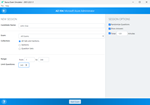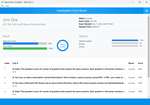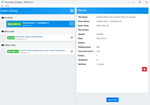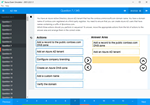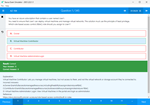Download Administering Microsoft SQL Server 2012-2014 Databases.70-462.CertKey.2019-01-14.182q.tqb
| Vendor: | Microsoft |
| Exam Code: | 70-462 |
| Exam Name: | Administering Microsoft SQL Server 2012/2014 Databases |
| Date: | Jan 14, 2019 |
| File Size: | 6 MB |
How to open TQB files?
Files with TQB (Taurus Question Bank) extension can be opened by Taurus Exam Studio.
Purchase
Coupon: TAURUSSIM_20OFF
Discount: 20%
Demo Questions
Question 1
You administer a Microsoft SQL Server database. The database has a table named Customers owned by UserA and another table named Orders owned by UserB. You also have a stored procedure named GetCustomerOrderInfo owned by UserB. GetCustomerOrderInfo selects data from both tables.
You create a new user named UserC.
You need to ensure that UserC can call the GetCustomerOrderInfo stored procedure. You also need to assign only the minimum required permissions to UserC.
Which permission or permissions should you assign to UserC? Each correct answer presents part of the solution.
- The Select permission on Customers
- The Execute permission on GetCustomerOrderInfo
- The Take Ownership permission on Customers
- The Control permission on GetCustomerOrderInfo
- The Take Ownership permission on Orders
- The Select permission on Orders
Correct answer: B
Explanation:
How Permissions Are Checked in a Chain When an object is accessed through a chain, SQL Server first compares the owner of the object to the owner of the calling object. This is the previous link in the chain. If both objects have the same owner, permissions on the referenced object are not evaluated. Due to ownership chaining, you would only need to give Execute permissions to UserC to access the Orders table since UserB is the owner. References: https://technet.microsoft.com/en-us/library/ms188676(v=sql.105).aspx How Permissions Are Checked in a Chain
When an object is accessed through a chain, SQL Server first compares the owner of the object to the owner of the calling object. This is the previous link in the chain. If both objects have the same owner, permissions on the referenced object are not evaluated.
Due to ownership chaining, you would only need to give Execute permissions to UserC to access the Orders table since UserB is the owner.
References: https://technet.microsoft.com/en-us/library/ms188676(v=sql.105).aspx
Question 2
You administer a Microsoft SQL Server 2012 database named ContosoDB. The database contains a table named Suppliers and a column named IsActive in the Purchases schemA.
You create a new user named ContosoUser in ContosoDB. ContosoUser has no permissions to the Suppliers table.
You need to ensure that ContosoUser can delete rows that are not active from Suppliers. You also need to grant ContosoUser only the minimum required permissions.
Which Transact-SQL statement should you use?
Correct answer: D
Explanation:
Incorrect:Not B: The dbo , or database owner, is a user account that has implied permissions to perform all activities in the database. This would go against the requirement to grant ContosoUser only the minimum required permissions.References:http://msdn.microsoft.com/en-us/library/ms188354.aspxhttp://msdn.microsoft.com/en-us/library/ms187926.aspx Incorrect:
Not B: The dbo , or database owner, is a user account that has implied permissions to perform all activities in the database. This would go against the requirement to grant ContosoUser only the minimum required permissions.
References:
http://msdn.microsoft.com/en-us/library/ms188354.aspx
http://msdn.microsoft.com/en-us/library/ms187926.aspx
Question 3
You use a contained database named ContosoDb within a domain.
You need to create a user who can log on to the ContosoDb database. You also need to ensure that you can port the database to different database servers within the domain without additional user account configurations.
Which type of user should you create?
- User mapped to a certificate
- SQL user without login
- Domain user
- SQL user with login
Correct answer: C
Explanation:
Contained user There are two types of users for contained databases. Contained database user with password Contained database users with passwords are authenticated by the database. Windows principals Authorized Windows users and members of authorized Windows groups can connect directly to the database and do not need logins in the master database. The database trusts the authentication by Windows. References: https://docs.microsoft.com/en-us/sql/relational-databases/databases/contained-databases?view=sql-server-2017 Contained user
There are two types of users for contained databases.
Contained database user with password
Contained database users with passwords are authenticated by the database.
Windows principals
Authorized Windows users and members of authorized Windows groups can connect directly to the database and do not need logins in the master database.
The database trusts the authentication by Windows.
References: https://docs.microsoft.com/en-us/sql/relational-databases/databases/contained-databases?view=sql-server-2017
Question 4
You administer a Microsoft SQL Server database that has multiple tables in the Sales schema.
Some users must be prevented from deleting records in any of the tables in the Sales schema.
You need to manage users who are prevented from deleting records in the Sales schema. You need to achieve this goal by using the minimum amount of administrative effort.
What should you do?
- Create a custom database role that includes the users. Deny Delete permissions on the Sales schema for the custom database role.
- Include the Sales schema as an owned schema for the db_denydatawriter role. Add the users to the db_denydatawriter role.
- Deny Delete permissions on each table in the Sales schema for each user.
- Create a custom database role that includes the users. Deny Delete permissions on each table in the Sales schema for the custom database role.
Correct answer: A
Question 5
You are the lead database administrator (DBA) of a Microsoft SQL Server environment.
All DBAs are members of the DOMAIN\JrDBAs Active Directory group. You grant DOMAIN\JrDBAs access to the SQL Server.
You need to create a server role named SpecialDBARole that can perform the following functions:
- View all databases.
- View the server state.
- Assign GRANT, DENY, and REVOKE permissions on logins.
You need to add DOMAIN\JrDBAs to the server role. You also need to provide the least level of privileges necessary.
Which three SQL statements should you use? Each correct answer presents part of the solution.
- GRANT VIEW SERVER STATE, VIEW ANY DATABASE TO [SpecialDBARole];
- CREATE SERVER ROLE [SpecialDBARole] AUTHORIZATION securityadmin;
- ALTER SERVER ROLE [SpecialDBARole] ADD MEMBER [DOMAIN\JrDBAs];
- CREATE SERVER ROLE [SpecialDBARole]; AUTHORIZATION serveradmin;
- GRANT VIEW DEFINITION TO [SpecialDBARole];
- CREATE SERVER ROLE [SpecialDBARole] AUTHORIZATION setupadmin;
Correct answer: ABC
Explanation:
References: https://docs.microsoft.com/en-us/previous-versions/sql/sql-server-2008-r2/ms175892(v=sql.105) References: https://docs.microsoft.com/en-us/previous-versions/sql/sql-server-2008-r2/ms175892(v=sql.105)
Question 6
You administer a Microsoft SQL Server database that has Trustworthy set to On. You create a stored procedure that returns database-level information from Dynamic Management Views.
You grant User1 access to execute the stored procedure.
You need to ensure that the stored procedure returns the required information when User1 executes the stored procedure. You need to achieve this goal by granting the minimum permissions required.
Which two actions should you perform? Each correct answer presents part of the solution.
- Grant the VIEW SERVER STATE permission to User1.
- Move the stored procedure to the User1 schema.
- Modify the stored procedure to include the EXECUTE AS OWNER statement. Grant VIEW SERVER STATE permissions to the owner of the stored procedure.
- Grant the db_datareader role on the database to User1.
- Create a SQL Server login that has VIEW SERVER STATE permissions. Modify the stored procedure to include the EXECUTE AS (newlogin) statement.
Correct answer: CE
Explanation:
References:http://msdn.microsoft.com/en-us/library/ms187861.aspxhttp://msdn.microsoft.com/en-us/library/ms191291.aspx References:
http://msdn.microsoft.com/en-us/library/ms187861.aspx
http://msdn.microsoft.com/en-us/library/ms191291.aspx
Question 7
You are migrating a database named Orders to a new server that runs Microsoft SQL Server.
You attempt to add a SQL login [User1], to the database. However, you receive the following error message:
"User already exists in current database."
You need to configure the [User1] login to be able to access the Orders database and retain the original permissions. You need to achieve this goal by using the minimum required permissions.
Which Transact-SQL statement should you use?
- DROP USER [User1];CREATE USER [User1] FOR LOGIN [User1];ALTER ROLE [db_owner] ADD MEMBER [User1];
- ALTER SERVER ROLE [sysadmin] ADD MEMBER [User1];
- ALTER USER [User1] WITH LOGIN [User1];
- ALTER ROLE [db_owner] ADD MEMBBR [User1];
Correct answer: C
Explanation:
The WITH LOGIN clause enables the remapping of a user to a different login. References: https://docs.microsoft.com/en-us/sql/t-sql/statements/alter-user-transact-sql?view=sql-server-2017 The WITH LOGIN clause enables the remapping of a user to a different login.
References: https://docs.microsoft.com/en-us/sql/t-sql/statements/alter-user-transact-sql?view=sql-server-2017
Question 8
You administer a Microsoft SQL Server 2012 database.
You configure Transparent Data Encryption (TDE) on the Orders database by using the following statements:

You attempt to restore the Orders database and the restore fails. You copy the encryption file to the original location.
A hardware failure occurs and so a new server must be installed and configured.
After installing SQL Server to the new server, you restore the Orders database and copy the encryption files to their original location. However, you are unable to access the database.
You need to be able to restore the database.
Which Transact-SQL statement should you use before attempting the restore?
Correct answer: C
Explanation:
To create a database protected by transparent data encryption The following procedures show you have to create a database protected by TDE using SQL Server Management Studio and by using Transact-SQL. Using SQL Server Management Studio 1. Create a database master key and certificate in the master database. 2. Create a backup of the server certificate in the master database. Etc. In transact sql:-- Create a database master key and a certificate in the master database. USE master ; GO CREATE MASTER KEY ENCRYPTION BY PASSWORD = '*rt@40(FL&dasl1'; GO CREATE CERTIFICATE TestSQLServerCert WITH SUBJECT = 'Certificate to protect TDE key' GO -- Create a backup of the server certificate in the master database. -- The following code stores the backup of the certificate and the private key file in the default data location for this instance of SQL Server -- (C:\Program Files\Microsoft SQL Server\MSSQL13.MSSQLSERVER\MSSQL\DATA). BACKUP CERTIFICATE TestSQLServerCert TO FILE = 'TestSQLServerCert' WITH PRIVATE KEY ( FILE = 'SQLPrivateKeyFile', ENCRYPTION BY PASSWORD = '*rt@40(FL&dasl1' ); GO Etc. ' References:https://docs.microsoft.com/en-us/sql/relational-databases/security/encryption/move-a-tde-protected-database-to-another-sql-server To create a database protected by transparent data encryption
The following procedures show you have to create a database protected by TDE using SQL Server Management Studio and by using Transact-SQL.
Using SQL Server Management Studio
1. Create a database master key and certificate in the master database.
2. Create a backup of the server certificate in the master database.
Etc.
In transact sql:
-- Create a database master key and a certificate in the master database.
USE master ;
GO
CREATE MASTER KEY ENCRYPTION BY PASSWORD = '*rt@40(FL&dasl1';
GO
CREATE CERTIFICATE TestSQLServerCert
WITH SUBJECT = 'Certificate to protect TDE key'
GO
-- Create a backup of the server certificate in the master database.
-- The following code stores the backup of the certificate and the private key file in the default data location for this instance of SQL Server
-- (C:\Program Files\Microsoft SQL Server\MSSQL13.MSSQLSERVER\MSSQL\DATA).
BACKUP CERTIFICATE TestSQLServerCert
TO FILE = 'TestSQLServerCert'
WITH PRIVATE KEY
(
FILE = 'SQLPrivateKeyFile',
ENCRYPTION BY PASSWORD = '*rt@40(FL&dasl1'
);
GO
Etc.
'
References:
https://docs.microsoft.com/en-us/sql/relational-databases/security/encryption/move-a-tde-protected-database-to-another-sql-server
Question 9
You administer a Microsoft SQL Server database.
You provide temporary securityadmin access to User1 to the database server.
You need to know if User1 adds logins to securityadmin.
Which server-level audit action group should you use?
- SERVER_STATE_CHANGE_GROUP
- SERVER_PRINCIPAL_IMPERSONATION_GROUP
- SUCCESSFUL_LOGIN_GROUP
- SERVER_ROLE_MEMBER_CHANGE_GROUP
- DATABASE_ROLE_MEMBER_CHANGE_GROUP
- SERVER_OBJECT_CHANGE_GROUP
- SERVER_PERMISSION_CHANGE_GROUP
Correct answer: D
Explanation:
The SERVER_ROLE_MEMBER_CHANGE_GROUP event is raised whenever a login is added or removed from a fixed server role. This event is raised for the sp_addsrvrolemember and sp_dropsrvrolemember stored procedures. Equivalent to the Audit Add Login to Server Role Event Class. Incorrect Answers:A. The SERVER_STATE_CHANGE_GROUP event is raised when the SQL Server service state is modified. Equivalent to the Audit Server Starts and Stops Event Class. B. The SERVER_PRINCIPAL_IMPERSONATION_GROUP event is raised when there is an impersonation within server scope, such as EXECUTE AS <login>. Equivalent to the Audit Server Principal Impersonation Event Class. C. The SUCCESSFUL_LOGIN_GROUP Indicates that a principal has successfully logged in to SQL Server. Events in this class are raised by new connections or by connections that are reused from a connection pool. Equivalent to the Audit Login Event Class. References:http://technet.microsoft.com/en-us/library/cc280663.aspx The SERVER_ROLE_MEMBER_CHANGE_GROUP event is raised whenever a login is added or removed from a fixed server role. This event is raised for the sp_addsrvrolemember and sp_dropsrvrolemember stored procedures. Equivalent to the Audit Add Login to Server Role Event Class.
Incorrect Answers:
A. The SERVER_STATE_CHANGE_GROUP event is raised when the SQL Server service state is modified. Equivalent to the Audit Server Starts and Stops Event Class.
B. The SERVER_PRINCIPAL_IMPERSONATION_GROUP event is raised when there is an impersonation within server scope, such as EXECUTE AS <login>.
Equivalent to the Audit Server Principal Impersonation Event Class.
C. The SUCCESSFUL_LOGIN_GROUP Indicates that a principal has successfully logged in to SQL Server. Events in this class are raised by new connections or by connections that are reused from a connection pool. Equivalent to the Audit Login Event Class.
References:
http://technet.microsoft.com/en-us/library/cc280663.aspx
Question 10
You administer a Microsoft SQL Server 2012 instance.
You need to stop a blocking process that has an SPID of 64 without stopping other processes
What should you do?
- Execute the following Transact-SQL statement:EXECUTE sp_KillSPID 64
- Restart the SQL Server service.
- Execute the following Transact-SQL statement:KILL 64
- Execute the following Transact-SQL statement:ALTER SESSION KILL '64'
Correct answer: C
Explanation:
Reference:http://msdn.microsoft.com/en-us/library/ms173730.aspx Reference:
http://msdn.microsoft.com/en-us/library/ms173730.aspx
HOW TO OPEN VCE FILES
Use VCE Exam Simulator to open VCE files

HOW TO OPEN VCEX FILES
Use ProfExam Simulator to open VCEX files


ProfExam at a 20% markdown
You have the opportunity to purchase ProfExam at a 20% reduced price
Get Now!